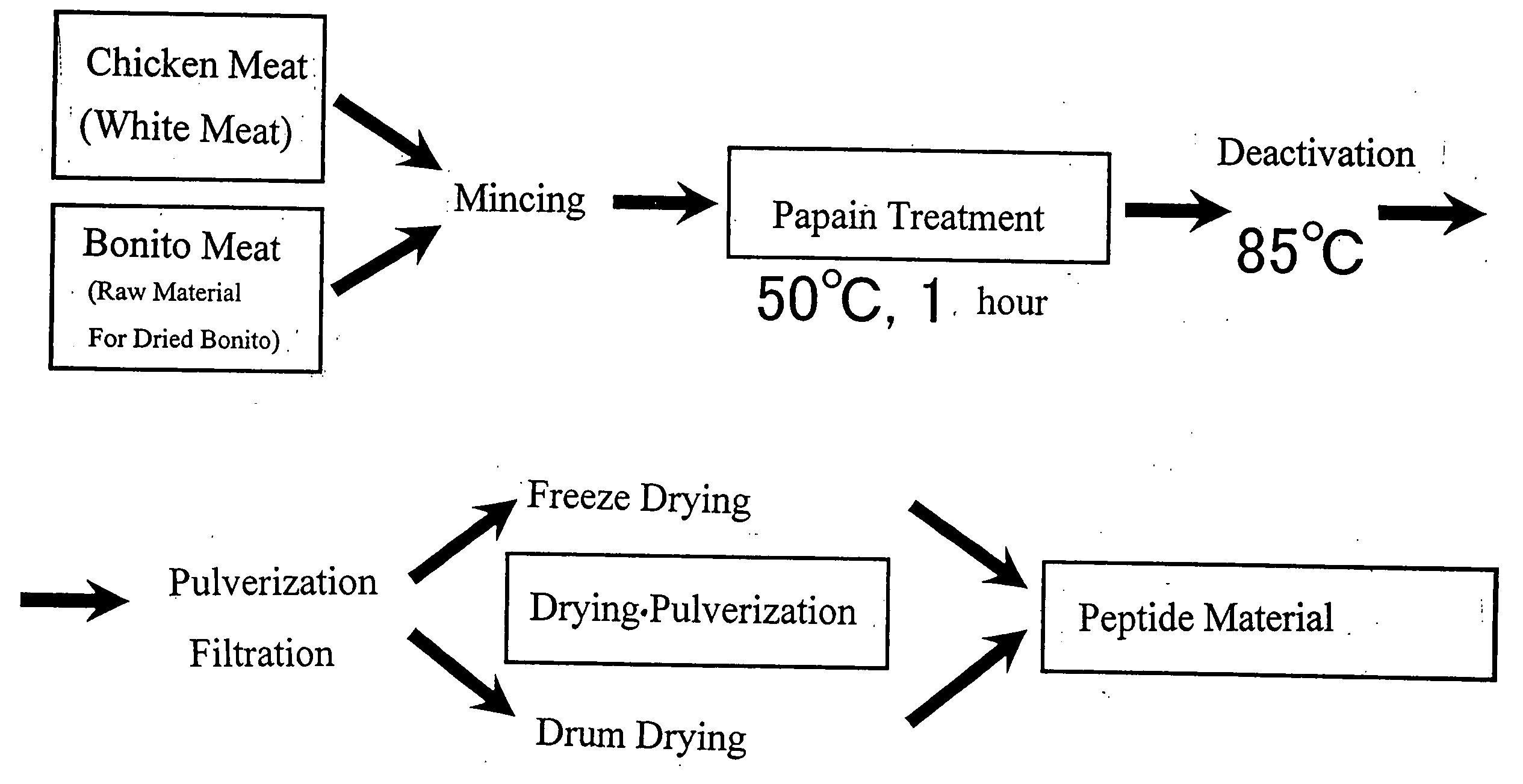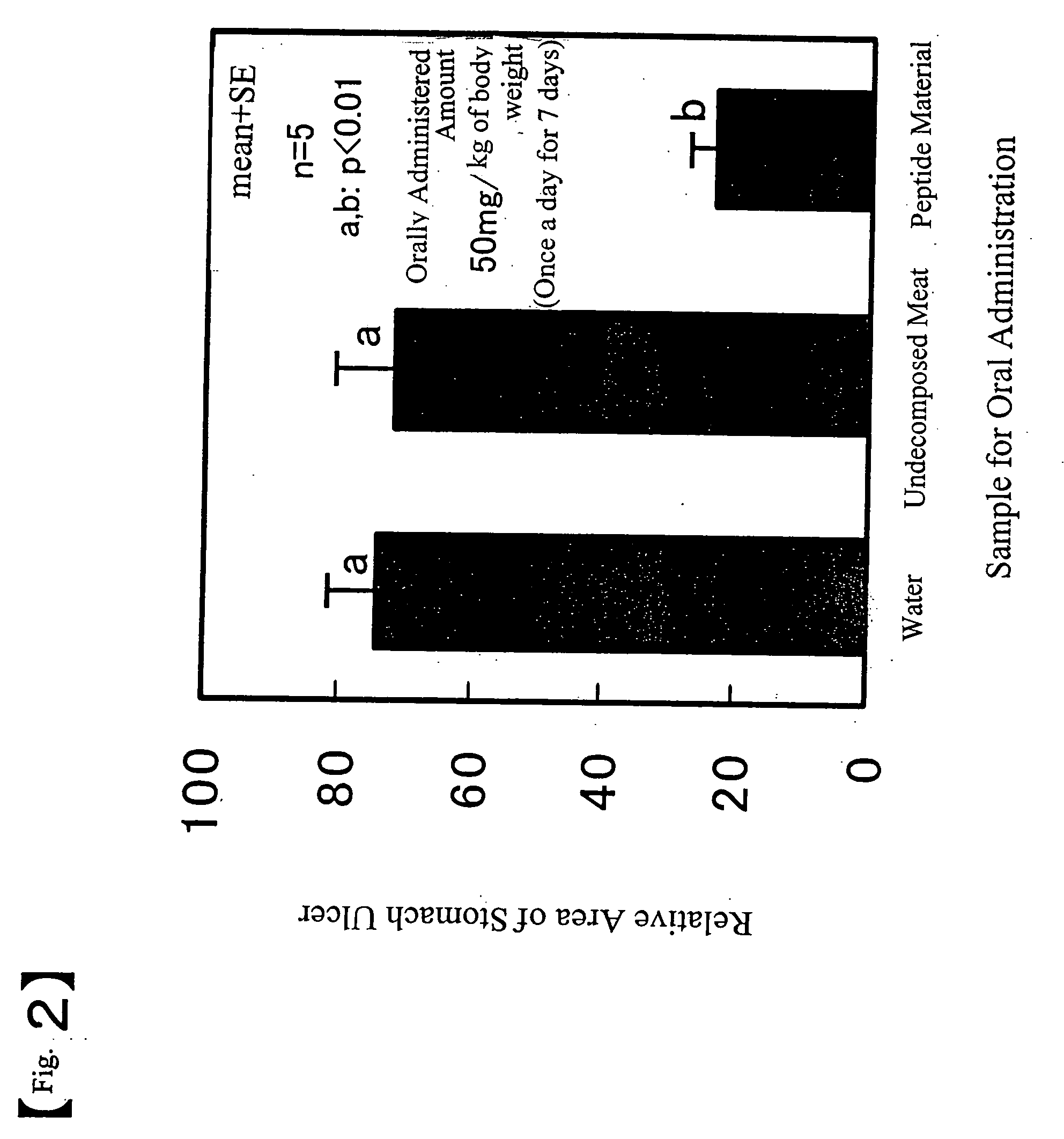Peptide pet food material having anti-stress action and palatability-increasing effect
a pet food and anti-stress technology, applied in the field of pet food materials, can solve the problems of decreased time for which pets contact their owners, increased stress on animals raised outdoors, and decreased palatability, so as to reduce stress on pets, increase palatability, and reduce burden
- Summary
- Abstract
- Description
- Claims
- Application Information
AI Technical Summary
Benefits of technology
Problems solved by technology
Method used
Image
Examples
example 1
Method of Preparing a Peptide Material Using Livestock Meat or Fish Meat as a Raw Material
[0047]The steps when preparing a peptide material according to the present invention using livestock meat or fish meat as a raw material are schematically shown in FIG. 1. In this example, chicken meat was used as livestock meat, and bonito meat was used as fish meat. After the removal of fat and connective tissue as much as possible, chicken meat (white meat of broilers) was thinly sliced and water was added to it so that it could be easily minced. Mincing was performed to obtain a nearly uniform meat suspension to which papain (purified papain FL-3 from Asahi Food and Health Care Corporation) was added to the suspension as a protease (0.25-1.50 weight %). After an enzyme reaction was carried out for one hour at 50° C., heating was carried out for one hour at 85° C. to deactivate the papain. The coagulated lumps which were formed by heating at this time were pulverized and formed into a somewh...
example 2
Effect of Preventing Stress-Induced Stomach Ulcers in Rats by Oral Administration of a Peptide Material
[0049]First, in order to verify the anti-stress action of a peptide material in laboratory animals, a test of the occurrence of stress-induced stomach ulcers was carried out using rats. Seven-week old male SD rats (Clea Japan, Inc.) were used as experimental animals. Rats in a test group were orally administered a peptide material (prepared by the same method as set forth in Example 1 from a chicken meat or bonito meat raw material), while rats in a control group were orally administered water or an undecomposed material (a meat material prepared without addition of papain). A test of the occurrence of stress-induced stomach ulcers was carried out as follows: Forced oral administration of one ml of the sample per 100 grams of body weight (5 mg as the material) was conducted once a day for seven days using a stainless steel stomach feeding tube, and after final administration, fasti...
example 3
Effect Exhibited in a Forced Running Stress Load in Mice Orally Administered a Peptide Material
[0051]The effect of oral administration of a peptide material prepared using chicken meat as a raw material during the application of a forced running stress load was investigated. The effect was determined by the change (elongation) in the running time when mice which were orally administered a peptide material were forced to run. The mice were 5 to 6-week old ICR males (Charles River Laboratories Japan Inc.). Forced running by the mice was carried out using a MK-680S treadmill (Muromachi Kikai Co., Ltd.) with the running surface sloped at 15° and a belt speed of 20 meters per minute. Prior to oral administration of a sample such as a peptide material, mice were forced to run for 4 hours on a treadmill, and after a certain degree of fatigue was reached, they were orally administered a test solution using a stainless steel stomach feeding tube. The amount of the orally administered test ma...
PUM
 Login to View More
Login to View More Abstract
Description
Claims
Application Information
 Login to View More
Login to View More - R&D
- Intellectual Property
- Life Sciences
- Materials
- Tech Scout
- Unparalleled Data Quality
- Higher Quality Content
- 60% Fewer Hallucinations
Browse by: Latest US Patents, China's latest patents, Technical Efficacy Thesaurus, Application Domain, Technology Topic, Popular Technical Reports.
© 2025 PatSnap. All rights reserved.Legal|Privacy policy|Modern Slavery Act Transparency Statement|Sitemap|About US| Contact US: help@patsnap.com



